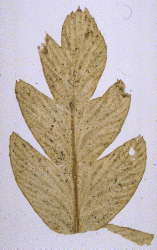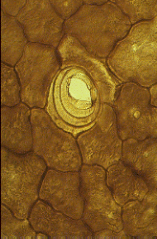
Lescuropteris
genuina |
 |
The Stephanian has yielded rich and varied compression floras including many
species of pteridosperms and cordaites. The pteridosperms or seed ferns
constitute a once very successful and widespread, but now completely extinct
group of seed plants with fern-like foliage. The classification of
compression fossils is based on purely morphological characters, such as
leaf shape and venation patterns. Unfortunately the same is true for the
cordaites, another common and widespread group of fossil gymnosperms with
strap-shaped leaves. Ongoing research should lead towards a better
understanding of natural relationships and ecology and concentrates on
290-300 million years old material from the Massif Central, France. From this
fossil material up to 7 cm long pieces of cuticle were obtained
in which every cell is still dicernable. |



